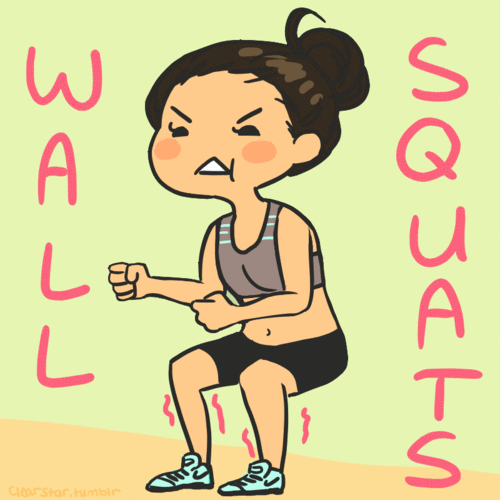10 MISTAKES TO AVOID WHILE DOING WALL SQUATS
Wall squats are a wonderful exercise that you can do anywhere, anytime, as long as you have a wall or door jamb to lean up against.
It strengthens weak muscles while doing a great job of helping to increase flexibility.
It is an excellent leg-strengthening exercise that works to make the quadriceps muscles stronger—one of the biggest muscles in your body.
And with all these benefits, if not done correctly, the wall squats won’t do much for you. Hence, following are 10 mistakes you should definitely avoid while doing wall squats.
#10 Wearing the wrong shoes

Your mistakes begin before you even arrive at the gym—in your closet to be exact. when you do compound, lower-body resistance movements like the squat, you should wear non-supportive, platform-like shoes that allow your foot to move and stabilize naturally.
#09 Letting Your Knees Turn Inwards or Outwards

Many knees turn in and much more turn outward while the body is lowered into the squat. Both of these movement patterns are maladaptive!
#08 Rounding or Arching Your Back
The most important cue from a safety perspective is to keep a neutral spine throughout the entire range of motion. It’s important to brace your pelvis in a neutral position and initiate the movement by hinging your hips back before bending your knees.
#07 Not Getting Low Enough
For a functional strength—the kind of strength that translates to better movement patterns and athletic performance—you need to move within your body’s full range of motion (ROM). Otherwise, you’re only strengthening specific segments of the muscles involved.
#06 Moving Too Quickly

Basically, the beginner fitness and/or injured person should move slower, do fewer sets and weight and more reps.
#05 Copying the Person Next to You
While there are key principles we all should follow when dropping it down low, how these principles are applied may look different depending on a variety of factors, including height, body shape, and length of your limbs.
The goal is to keep the spine stable as your torso leans forward while squatting down and straightens up when returning to standing. This amount will vary from person to person as will squat depth and foot placement when doing body weight and when under load.
#04 Placing Your Feet Incorrectly
If you're tall, you'll probably find edging your feet more towards shoulder width is beneficial. However, this could be jeopardizing your balance. Your feet should be placed between hip- shoulder distance apart. This gives you the optimum foundation to squat.
#03 Lifting Your Heels

To do a perfect squat, you should be lowering your weight into your heels, not away from them.
#02 Wandering Eyes
Stay focused. Eyes should be straight ahead. 'If you're in front of a mirror, meet your own gaze throughout. Looking around will stop your spine from being locked into a strong position

#01 Not Making Adjustments Based On Your Goals and Needs

The beauty of the squat is that it can be scaled to any ability level. Just as squats look differently on everybody they can—and should—be modified depending on the individual needs.
What are Wall Squats Good for?
Wall squats target the quadriceps, hamstrings, glutes, and calves, improving endurance, stability, and posture. Strengthening supporting muscles can also help reduce knee and back pain.


